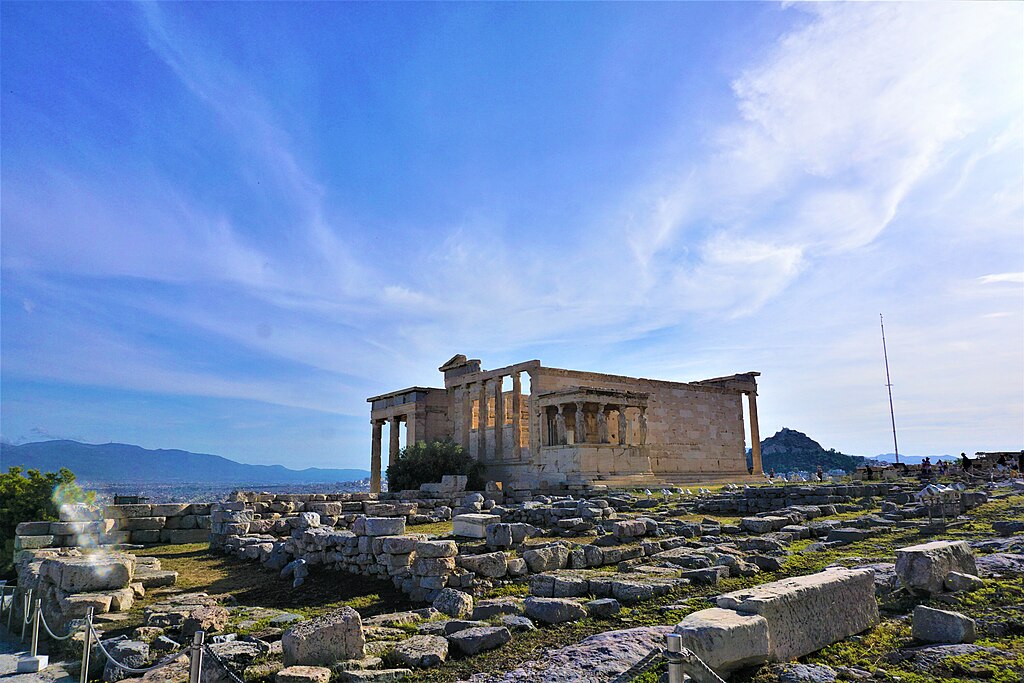
“Spring” by Lawrence Alma-Tadema depicts the festival of Cerealia in a classical Roman marble terraced street. In ancient Roman religion, the Cerealia was the major festival celebrated for the grain goddess Ceres.
It was held for seven days from mid to late April, and this painting shows the procession of women and children descending marble stairs carrying and wearing brightly colored flowers.
Cheering spectators fill all the vantage points of the classical Roman buildings. Tadema’s curiosity about the ancient world of Greece and Rome was insatiable.
Lawrence Alma-Tadema historical knowledge is incorporated into this painting through architectural details, dress, sculpture, and ornaments that are based on Roman originals.
This painting is one of Tadema’s most famous works, and it took him four years to complete. The models for many of the participants and spectators were Tadema’s friends and members of his family.
Tadema also echoed the Victorian custom of sending children into the country to collect flowers on May Day and links such cultural activities across the world to this festival’s great antiquity. The artist claimed:
“.. if you want to know what those Greeks and Romans looked like… come to me. I can show not only what I think but what I know.”
Cerealia
A nighttime ritual described by Ovid indicates the Cerealia festival’s archaic nature. Blazing torches were tied to the tails of live foxes, which were released into the Circus Maximus.
The purpose of this ritual is unknown, but it may have been intended to cleanse the growing crops and protect them from disease and vermin or to add vitality to their growth.
Ovid offers the Origin Myth story that, a long time ago, a farm-boy caught a fox stealing chickens and tried to burn it alive.
The fox escaped, ablaze; in its flight, it fired the fields and their crops, which were sacred to Ceres and thus ever since foxes are punished at her festival.
Ceres
In ancient Roman religion, Ceres was a goddess of agriculture, grain crops, fertility, and motherly relationships.
She was initially the central deity in Rome’s cult of the Roman gods, and then she was paired with her daughter Proserpina in what Romans described as “the Greek rites of Ceres.”
Her seven-day April festival of Cerealia included the favorite Ceres’ games. She was also honored in the May purification ceremony of the fields, at harvest-time, and during Roman marriages and funeral rites.
The Romans saw her as the counterpart of the Greek goddess Demeter, whose mythology was reinterpreted for Ceres in Roman art and literature.
Lawrence Alma-Tadema
Sir Lawrence Alma-Tadema (1836 – 1912) was a Dutch painter with special British denizenship (permanent residency). Born in the Netherlands, and trained at the Royal Academy of Antwerp, he settled in England in 1870 and spent the rest of his life there.
A painter of classical-subjects, he became famous for his depictions of the decadence of the Roman Empire, with languorous figures set in fabulous marbled interiors or against a backdrop of the blue Mediterranean Sea and sky.
In London, Alma-Tadema found a ready market among the wealthy middle classes for paintings re-creating scenes of domestic life in imperial Roman times and Ancient Greek views.
Though admired during his lifetime for his skills in the depictions of Classical antiquity, his work fell into disrepute after his death. Only since the 1960s has it been re-evaluated for its importance within nineteenth-century British art.
Spring
- Title: Spring
- Artist: Lawrence Alma-Tadema
- Year: 1894
- Type: Oil on panel
- Dimensions: Height: 178.4 cm (70.2 ″); Width: 80.3 cm (31.6 ″)
- Museum: Getty Museum
Lawrence Alma-Tadema
- Artist: Lawrence Alma-Tadema
- Born: 1836, Dronrijp, Netherlands
- Died: 1912 (aged 76), Wiesbaden, German Empire
- Nationality: Dutch, British denizenship
- Movement: Academicism
- Notable works:
- Sappho and Alcaeus
- Spring
- The Finding of Moses
- Self-Portrait
A Virtual Tour of the Getty Museum
- “The Grand Canal in Venice from Palazzo Flangini to Campo San Marcuola” by Canaletto
- “Modern Rome – Campo Vaccino” by J.M.W. Turner
- “Irises” by Vincent van Gogh
- “After the Bath, Woman Drying Her Back” by Edgar Degas
- “Wheatstacks, Snow Effect, Morning” by Claude Monet
- Portrait of a Halberdier by Pontormo
- Spring by Édouard Manet
- Greek Kouros (Getty Museum)
- Spring by Lawrence Alma-Tadema
- “Portrait of a Man” by Paolo Veronese
- Euclid by Jusepe de Ribera
Alma-Tadema: At Home in Antiquity
Sir Lawrence Alma Tadema: A collection of paintings
Lawrence Alma Tadema’s Residence in London
~~~
” You may forget but
let me tell you
this: someone in
some future time
will think of us.”
– Sappho
~~~
Photo Credit: Lawrence Alma-Tadema [Public domain]
Popular this Week








 Sponsor your Favorite Page
Sponsor your Favorite Page SEARCH Search for: Search Follow UsJoin – The JOM Membership Program
Sponsor a Masterpiece with YOUR NAME CHOICE for $5
Share this:
- Tweet
